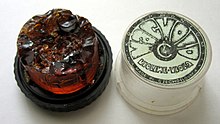
Back Hars Afrikaans راتنج Arabic Resina AST Papaskiw (irinacitc) ATJ Qatran Azerbaijani کیتیرگه AZB Ыҫмала Bashkir Baambeech BAR Смала Byelorussian Смола Bulgarian



Resin is a mixture of organic compounds secreted by many plants, especially coniferous trees.
Plants evolved many complex chemicals as defences against herbivores. That may be the origin of these resins, which are certainly not good to eat. Plants secrete resins for their protective benefits in response to injury.
The resin protects the plant from insects and pathogens.[1] Resins confound a wide range of herbivores, insects, and pathogens. The volatile phenolic compounds may attract benefactors, that is, parasitoids or predators of the herbivores which attack the plant.[2]
Humans also value resins for their many uses. They are used in varnishes, adhesives, as raw materials for organic synthesis, or for incense and perfume. Fossilized resins are the source of amber. The term is also used for synthetic substances with similar properties.
Resins contain chemicals composed of carbon, hydrogen, oxygen, nitrogen and sulfur. Synthetic resins are used in laminates, adhesives, flooring, linings, etc.[3]
- ↑ "Resins". www.fs.fed.us.
- ↑ Langenheim, Jean 2003. Plant resins: chemistry, evolution, ecology, and ethnobotany. Timber Press, Portland OR.
- ↑ "Resin Bonded Stone". Resin Bonded Stone. Retrieved 2020-11-01.
© MMXXIII Rich X Search. We shall prevail. All rights reserved. Rich X Search